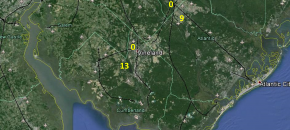I have observed a lot of emerged Palmer amaranth seedlings. Early planted corn should be scouted at 4 weeks after planting to determine if a POST herbicide application is needed. A lot of no-till soybean fields need a burndown herbicide, and if Palmer amaranth is present in those fields, it makes things challenging. If the […]
Continue reading...Potato Disease Forecasting Report 5-23-14
Potato Disease Forecasting Report 5-23-14 – Click to Download We will be tracking DSVs for Late blight development and calculating P-days for initiating the first early blight fungicide application. The first late blight fungicide application is recommended once 18 DSVs accumulate from green row. Green row typically occurs around the first week in May in southern […]
Continue reading...Tomato Disease Forecasting Report 5-23-14
5-23-14 Tomato Report – Click to Download Disease severity values (DSVs) for early blight, septoria leaf spot, and tomato anthracnose development are determined daily based on leaf wetness (due to rainfall, dew) and air temperature. On a daily basis DSV values can range from 0 to 4 where 0 = no chance for disease development […]
Continue reading...Invasive Emerald Ash Borer Detected in NJ
New Jersey Department of Agriculture today confirmed that the emerald ash borer (EAB), an invasive beetle that attacks and kills ash trees, has been found in Somerset County by a landscaper investigating unhealthy trees in a Bridgewater retail area last week. Inspectors sent insect larvae samples to the USDA where the specimens were confirmed.
Continue reading...Veg IPM Update: Week Ending 5/21/14

Vegetable IPM Report 5-21-14 – Click to View | Download | Print Maps for the Week –Pepper Weevil Trap Catch Map –European Corn Borer Population Map Topics for the Week Sweet Corn Cole Crops Peppers Tomatoes Pepper Weevil Report BMSB
Continue reading...Yellow Sweet Corn
Sweet corn that has emerged has been observed yellow or light green in color. The chlorosis may be uniform, or appear mottled on the plant, or only the newest leaf growing out of the whorl is yellow. Cold weather is responsible for the injury. Corn cannot make chlorophyll when the temperature fails to climb above […]
Continue reading...